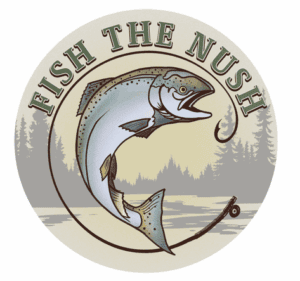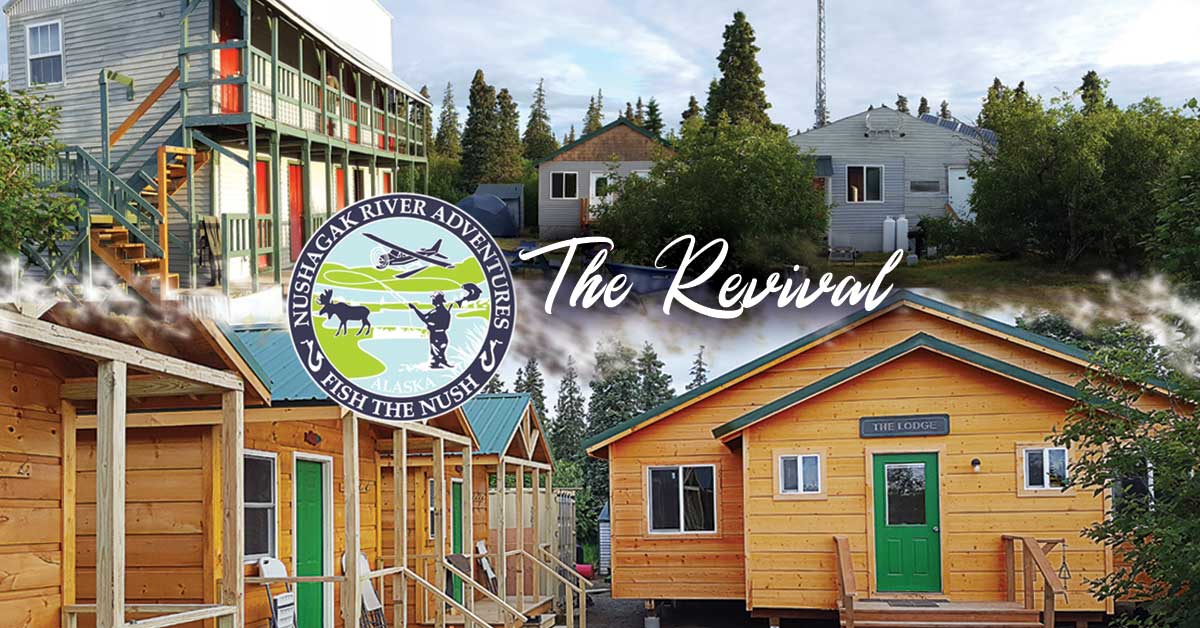Bristol Bay lodge Revival: A camp turned lodge on Alaska’s Nushagak River
by Pete von Jess
“What have I gotten myself into?” I asked out loud standing on the grounds of the Bristol Bay lodge I had just purchased. And that was before my client’s foot went through a rotting stair tread. I stared up at the dilapidated building meant to house guests. I had just taken possession of this ramshackle camp on a choice piece of property in the most glorious of God’s country, smack dab in the middle of the most illustrious wild king salmon fishery known to man.
The Nushagak River is a place I’ve come to love in the years I have been coming here to fish. Alaska’s Bristol Bay, a name that evokes images of millions of salmon and pristine water, rolling tundra, mixed coniferous/birch forest, muskeg and willow alder thickets, moose, caribou, brown bear, river otters and somewhere near 150 different species of birds.
I’ve learned it’s actually much more than that. It’s home to a traditional lifestyle that matters. It’s a vital food and economic resource to the world, and it’s a getaway for many people from all over the globe each summer who seek solace on the rivers.
I found the Nushagak with my fishing buddy Dr. Bob, once we had both experienced enough of a busy and crowded Kenai. We became guests of this Bristol Bay fish camp and instantly became enamored with the beauty and solitude of the river complete with unpressured and unparalleled, world-class, wild king and coho fisheries. I’ve been coming to Alaska for 10 years now and it never gets old.
In the fall of 2016 I heard from the guides at Nushagak River Adventures Lodge that the business was tied up in bankruptcy court and some staff hadn’t been paid for the season. Often I find I am the guy people call when they need help. I spent time over those next three months trying to negotiate their full payment until I learned the only way to do that would be to buy the business. So I did.
A month after I became the owner of Nushagak River Adventures Lodge, on an exploratory mission with my brother-in-law Stephen White and Army buddy Bruce Condrey, we came to Alaska to figure out the necessary steps to make a clean and safe camp. Escorted by Portage Creek’s sole year-round resident Chris Carr, we rode out to the property on snow machines in February at minus fifteen degrees. I am pretty sure even a 30-minute snow machine ride at that temperature unofficially makes one an instant Alaskan. We descended on the camp to document the findings. Chilled and excited, I couldn’t tell what was making me shake, the freezing air or Stephen teasing me about where I was putting up the next building followed by my own quick response that some had to come down first. Bruce was animated with ideas too, but it wasn’t until we were back in Dillingham that we would seriously begin to consider options for this Bristol Bay lodge. People close to me know me to be an avid list maker. We drew out a proportionate approximation of the camp and made a handy-dandy list prioritizing what needed to be done. In that moment, I could not fathom what would unfold over the next few years.
Fast forward home to our respective states on the east coast and we began to assemble a build plan. We quickly determined Stephen would be our general contractor with his 40 years of experience in that role. He was tasked to lead the initial build team to include his highly capable sons David Durkin and Brett White, myself, as well as Bruce Condrey and another good Army buddy Dwayne Whaley. We would also enlist some of the guides for help.
I reflected on how 22 years as an operations and logistics planner for the US Army and another 18+ years in the corporate world becoming CEO of a 500-person-plus company would serve me well. Running a remote camp in Alaska was another use of my skill sets.
Alaska’s construction season is limited from spring to fall. That summer we would host clients and begin phase one of reconstruction for what would become our top quality Bristol Bay lodge. To prepare, Bruce and I met at Sisson Log Homes in Blue Ridge, Georgia, to select the lumber—a 1 x 12-inch shiplap siding that would pack and ship well in the 20-foot metal containers I purchased. Later that month Stephen met me in Seattle to buy the metal roofing, hardware, tools, appliances and requisite household goods.
While the building materials were being acquired, I hired the guides for the summer and laid plans to improve the overall experience for guests. One of the many steps in the right direction was to upgrade the boat and motor fleet as well as all of the fishing gear. That summer I added three new Alumaweld boats and powered them with 60 HP outboard Mercury motors plus 8 HP Mercury kickers. Deep breaths are helpful when you shell out this kind of coin! I also bought all new Lamiglas rods and Daiwa reels. I strive for the best so there wasn’t any real hesitation, it had to be done. We were well on our way to the first season running this Bristol Bay lodge.
We arrived in Dillingham, Alaska, the last week of May 2017 and flew to the lodge by float plane where we would meet the river barge bringing our containers and materials. Ten guys met four 20-foot containers jam stuffed with lumber, sonotubes, and cement, plus a summer’s worth of propane, gasoline and diesel, and a Zoom Boom heavy-duty forklift I rented to move these 20-foot containers from the barge to the property once empty. As we unloaded the seemingly endless amount of equipment and construction materials I was very thankful I had purchased my nephew’s skid steer—the first of many, many times I would have that thought. The property became a construction encampment with so many piles there wasn’t much room to walk. We planned to build a sound barrier around our Northern Lights 16kW generator with the containers, but when the forklift operator sunk into the newly thawed tundra we abruptly changed the plan and placed them closer to the river.

The camp at the beginning of the 2017 season.
It took the first seven days just to clean the camp from 20 years of neglect and accumulated debris literally everywhere. I assigned a crew to build a fuel spill area for three 500 gallon fuel tanks and rebuild the frames for the storage tanks. Many pivotal moments occurred that first season. Once I realized I had the four 20-foot containers to repurpose we determined they would be best suited to house tools, fishing, boating and maintenance items, and household and cleaning supplies. We had originally intended to build eight cabins—four along the back row and four more along the north side of the property forming an L shape. The back row of cabins was originally meant to be all 12 X 20’ cabins. A tree we wanted to keep prohibited that plan so we ultimately built five cabins there—three of them at the original scale to sleep four and the other two as 12 x 16’ for two people each. Once we built shelves for the storage containers, my next thought was to knock over the “guide shack” but the staff urged me to keep their private quarters.
We were towards the end of June 2017 at this point and our attention was focused on removing the two rotting and unsafe decks on the client dorm building. Clients had been coming through watching daily progress with wide eyes. A new solar system was installed over the kitchen. During that process, a client pushed his foot through a rotten tread on the exterior stairway of the dormitory-style client building. “Exactamundo,” I thought. It was then that Stephen and I collaborated and I made the decision to tear that building down, and it was the right one. So, I decided to assign the clients to the newly built cabins for their sleeping quarters to keep them safely out of the construction zone. We altered the build plan to create the second row of cabins on the south side now that the client two-story building was gone. We were able to construct cement stub columns for the four cabins and build out two of them with the remaining lumber. We headed home that August with a lot more understanding of what we needed to do to construct this Bristol Bay lodge and a handy-dandy list (go figure) of additional items to procure.
As soon as we hit the lower 48, preparation began for 2018. Additional tools were required, a new chef was needed, and new camp hands/housekeeping staff would need to be hired. While the fishing guides were solid, I needed more guides because the 2018 client count was significantly higher. On the build side it was clear I needed an expert electrician and pIumber. My nephew David, a deft stone mason, had come to North Carolina to help landscape our new family lake home when we returned from Alaska. It was during that time we met Jamie Mundy, who also has a home on the lake, a couple houses away. As it turned out he was the kind of skilled expert I needed to hire for electrical and plumbing. A little fate at work there.
Stephen and I began my notorious list-making process in October for the spring ahead. I ordered the lumber from Sisson Log Homes and this time it fit in one container that upon arrival would be unloaded and become our fish-processing facility. We would run electricity to it once placed. We knew we needed to build two more cabins on the site of the former two-story client dorm. We also knew, with the summer of 2017 fresh in mind, that the dining facility and “guide shack” needed a facelift. We started to address the idea that a main lodge would be significantly better than the currently separated kitchen and dining area. The lodge would be placed near the river with the kitchen and dining under one roof and sleeping quarters for the chef and camp staff above the kitchen. The dining facility would be transformed to a bathroom facility with separated men’s and women’s rooms. That winter I also purchased three more 20-foot Alumaweld boats and 8HP Mercury kicker motors, but we upgraded to 90HP Mercury motors for the first six Alumaweld boats in the fleet.
We set to task buying bed linens, pillows, fleece blankets, comforters, kitchen equipment, exterior doors, and vinyl flooring for all nine cabins filling another container that would return to Dillingham for offsite storage. A new 36kW “whisper-quiet” diesel generator was purchased to rid ourselves of the very noisy 16kW Northern Lights diesel generator.

Various stages of the build over the years.
Spring arrived like clockwork. My dry-erase board listed the following and then some—build two cabins, place siding on the guide dorm and dining room, relocate the new solar-panel system over to the dining facility, and build a pump house over the new well. Our plan went off without a hitch…until it was time to inspect the guide dorm. Stephen and I found black mold and immediately condemned the building. We decided to build a new 24 x 36’ staff dorm, doubling the size of the individual rooms and addressing the need for a full compliment of eight guides. We pushed the old building over and took it apart to burn on the beach, following every safety protocol as we always do, and sent the metal roof down river on the barge.
Two days later concrete pilings were sticking out of the ground, and after a few more days there were beams, floor joists, and ¾-inch flooring all installed just as our season was ending. Ron Logan, one of our excellent fishing guides, also happens to be amply capable in construction. I asked Ron to stay on the payroll a little longer to help Stephen frame the guide dorm. With the interior and exterior walls erected and the ceiling in place, it was time to install the roof. I climbed the ladder to visit with them. Handing them each a water, I said, “I have been thinking. The lodge really shouldn’t be up near the river. We just can’t chance it with erosion or ice break up. What if we build the main lodge by expanding what is currently the dining hall, instead of converting that to the bathhouse?” Stephen nodded, “That can be done.” “Then we can build a new bathhouse where the kitchen and bath currently are,” I added. “One problem, we can’t build up with the current roof line over the kitchen so we lose the second floor that was to be quarters for the chef and camp staff.” So, I asked Stephen and Ron to add another floor to the staff dorm they were currently framing. Stephen once again pronounced it could be done so I made haste scurrying back down the ladder before I was invited to depart another way. Since everyone agreed that was a good solution the knee walls were put up within the hour. The rafters and green roof were installed and the summer ended with a new staff dormitory raised and the dining room framed to become a commercial kitchen. The makings of a completely new Nushagak River Adventures Bristol Bay lodge were coming to fruition.
Through the later half of 2018 into early winter 2019, Stephen created the plan for The Lodge complete with mud room and commercial kitchen. Another complex design was created for a new bathhouse and laundry facility to be placed on the same real estate as the existing run down bathhouse/laundry/kitchen. Plans were finalized and materials purchased. We added two more Alumaweld boats to the fleet for a total of eight and replaced any necessary fishing gear. We purchased the new commercial kitchen appliances, shelving and storage and picked out some lodge décor. I began to think about dining furniture for the main lodge and ultimately commissioned North Carolina finish carpenter Brian Willett to design six 5 X 5’ square tables that could be configured in a variety of ways for our groups. Now with two years of river barge experience, food and fuel resupply coordination was relatively easy to achieve and the lodge was coming to life. We were ready for the summer of 2019, our biggest build year yet.
In late May 2019, we unloaded our supplies and began to pour concrete pilings for the new Bristol Bay lodge and mud room. Soon beams, joists, flooring, exterior walls, and timber-frame rafters were installed. Tongue in groove 2 x 6” ceilings were added then green tin roofing topped it. The lodge was completed in record time with the hardwood floors finished just hours before the first clients arrived! While our lodge was under construction, three guides completed the fiberglass and plywood installation on the new dorm walls for both floors. Stephen placed the exterior doors, and we painted doors and trim, and stained the building’s exterior again.
Since the new commercial kitchen was now fully operational we tore down the kitchen side of that old rundown building but had to leave the bathhouse side in place for guests. On August 16, the day the last clients departed camp for the season, we shut off the electricity and water to the existing bathhouse and tore that building down. Stephen built the Taj Mahal of side-by-side outhouses that would serve us while the bathhouse was out of commission. Seven days later we had prepared the construction site, poured cement pilings, built the new laundry and bathhouse building, installed rafters and the roof. Our Bristol Bay lodge was well underway. We connected electrical wire and as many electrical boxes as we had on hand. Windows were added but door frames were boarded up on the roughed-in building. As this building was being constructed, I began to experience severe back pain. After toughing it out for a week, I called the local medical clinic in Dillingham and hired a helicopter to bring me to town. The medical staff knew that I was days from going home, so they prescribed heavy sedatives and muscle relaxers and sent me back to the Bush where we finished winterizing the lodge and then headed home to our families.
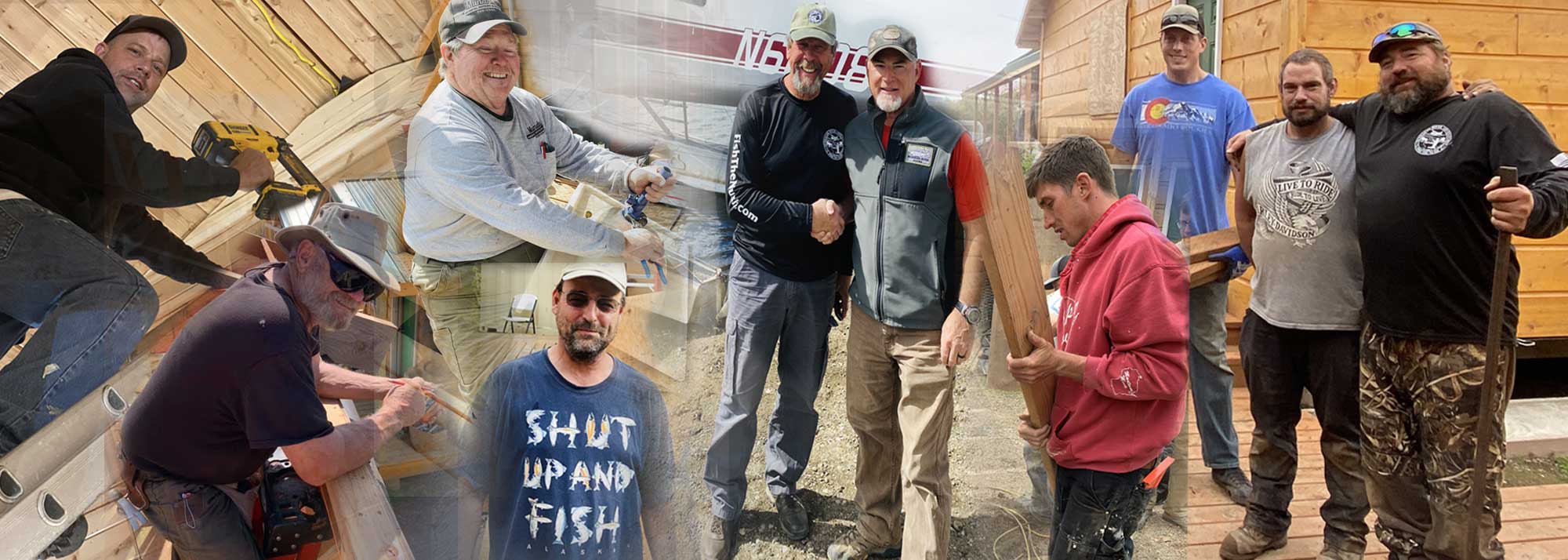
True friends and skilled craftsmen, we could not have accomplished such success without an incredible team.
Planning for 2020 was the easiest yet for purchasing and moving supplies. I needed to get the final accoutrements that the lodge, bathhouse, and camp in general needed, ship exterior doors and interiors doors for the new building, and purchase three years of oil, air, and fuel filters and other maintenance items. We also purchased toilets, sinks, and shower units, as well as a vast amount of plumbing PVC pipe and electrical materials. We chose LED lights throughout the camp.
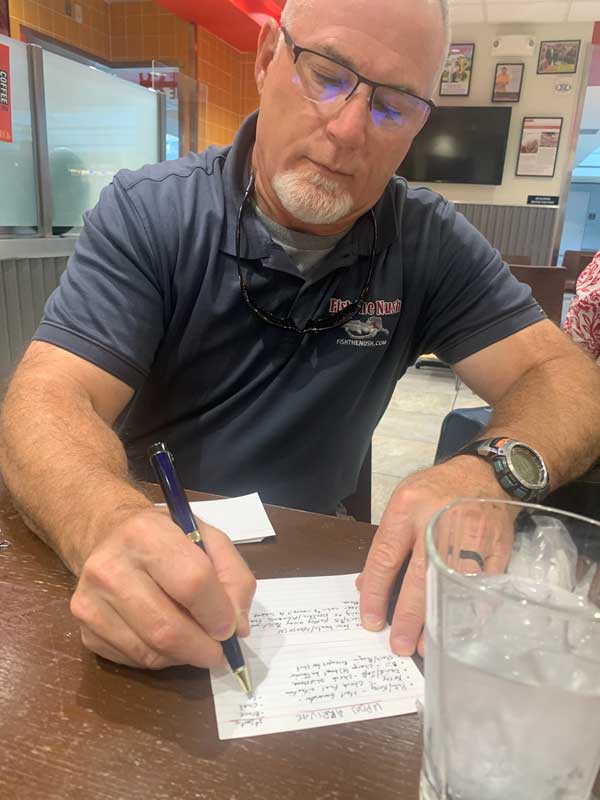
The list master at work.
And while planning had become relatively easy at this stage, it was a head banger on four other fronts. 2020 threw us all some curve balls; including the Covid-19 pandemic. We had several other doozies. First, Stephen came down with a respiratory illness (unrelated to CV-19) which forced him to be benched in early 2020. We lost our general contractor and building expert. Thankfully we had enough time to form a new team with each member knowing they were in a no-fail position. Second, as a reaction to the Covid-19 pandemic, the state of Alaska and the municipality of Dillingham enacted ever changing and more restrictive mandates for travel. In late March, the decision to cancel the season due to these stringent restrictions was warranted. With that decision made, the third curve ball was that I met with a neurosurgeon, and despite the pandemic and undesired procedures, my back surgery was scheduled for April 2. My neurosurgeon removed the bad (non-existent) disk and installed a metal spacer with several screws that will fuse together. The remainder of April and all of May were recovery months with physical therapy. When I cancelled our fishing season I decided to proceed to Alaska with my build team, taking all the necessary precautions so I began preparation for the one-month final build out of the camp in June. The final bump in the road was learning that the camp had been flooded when the river swelled and backed up due to an ice jam at the mouth of the river on a low tide. We are close enough to the bay that we experience tidal rises and drops. During low tide, if the breaking ice from the spring melt clogs the bay, the water backs up the river until high tide when it can rush out to sea. That infrequent natural incident occurred in April 2020, which validated building the lodge away from the river.
On June 5th of this year, my team gathered in Anchorage and the next morning we flew on a chartered aircraft to King Salmon, then onward to Nushagak River Adventures Lodge by float plane. My nephew David led the construction team creating the decks and walkways. His team mixed and poured a legion of cement footings and headways. David, along with brothers Corbin and Ted Gibson, nicknamed themselves The Deckheads. Meanwhile, Chef Chris Lee kept us well-nourished while Jeff Newhouse and John Corbett focused on the interior of the new bathhouse and Jamie Mundy and his grandson Sam, attended to all plumbing and electrical. Bill DeAvilla performed annual maintenance on all of the Mercury motors, and inventoried and put away all of the additional fishing and boating supplies. Bruce installed ten security cameras and tied them into the internet. He also built a standalone solar-power source for the security cameras. When Bruce Condrey and Korey Siltman had to depart in mid-June to attend to personal affairs, we flew in Chris Titus, (one of our fishing guides who resides in Alaska) and Mark Haller (the most experienced solar-system installer in Alaska). Chris took over the camp manager duties and finished the mud room. Mark assessed our solar system, installed another (standalone) solar system and concluded that the weight of the snow on the solar panels caused damage that must be repaired.
While the main effort was “finishing” the bathhouse, we also leveled a deck for the chef to cook on the grill, built and installed two barn-style doors on the storage compartment of the bathhouse building, installed attic vents for air circulation, raised several containers by 18 inches to prevent flood water surge from entering, and re-dug the outhouse whose hole had filled in with rain and flood waters. We also installed flanged vents in the peak of each sleeping cabin to allow the warm air to escape, built a concrete walkway around the fuel spill containment area, installed a new propane water-heater system, upgraded the internet access points and tweaked the satellite system. It was a busy month but finally my vision was becoming reality.
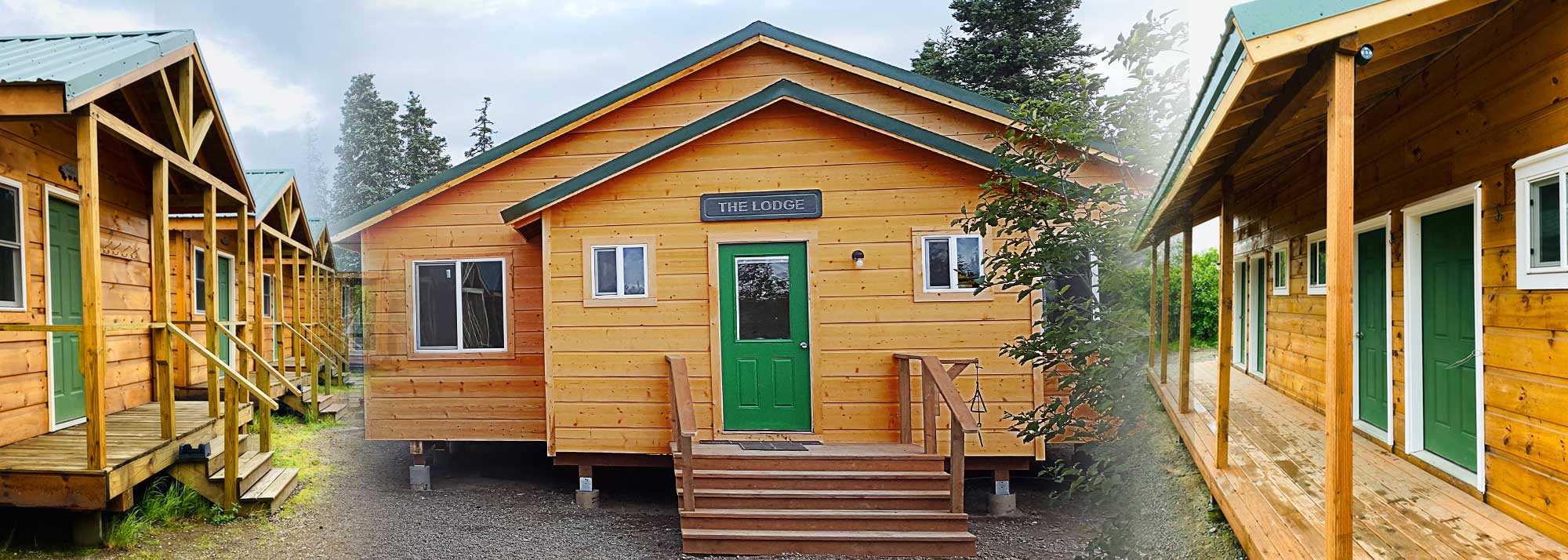
The main lodge, cabins and staff dorm.
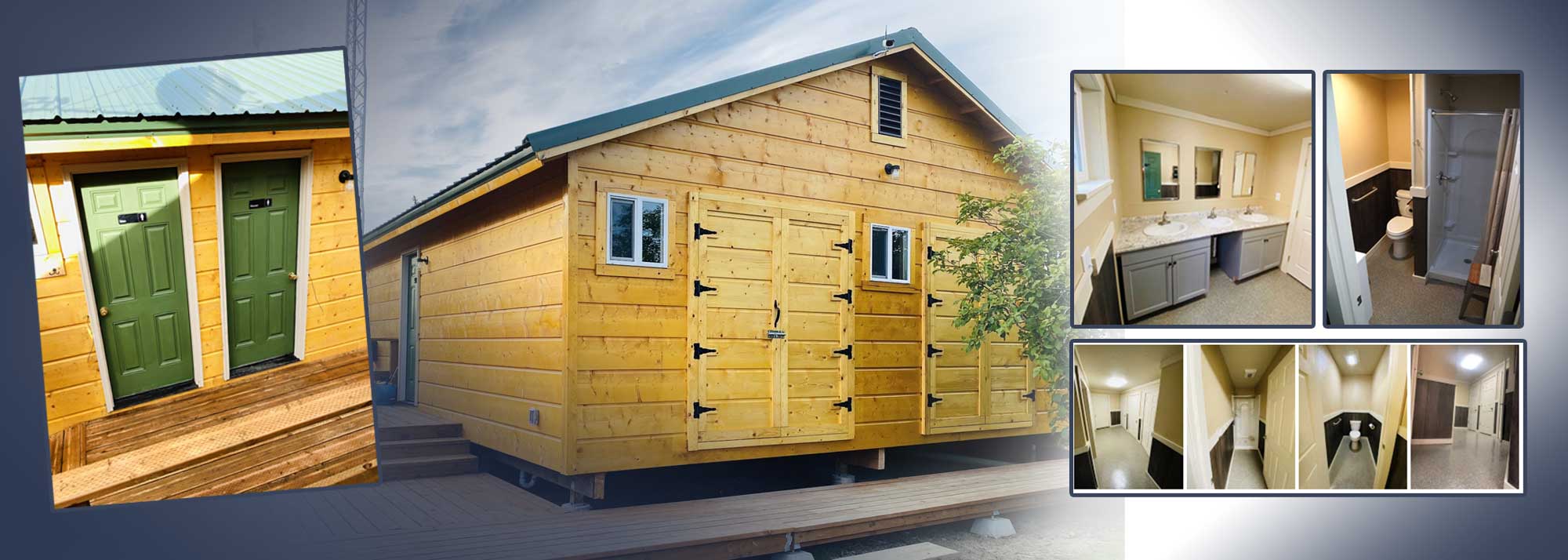
The new bathhouse has ample room and separate facilities for men and women.
Once The Deckheads built the walkways, decks and ramp around the beautiful, new bathhouse facility, we easily connected it to the existing guide dorm porches. Then the new overlook deck facing the river was completed. My nephew, David, approached me and said “I know it wasn’t the plan, but it makes perfect sense to connect that river overlook deck to a new walkway giving the front four cabins raised-walkway access to the lodge and bathhouse.” I agreed and added it also made sense to build a connecting walkway for the back five cabins to the bathhouse and lodge from the other direction. It was decided a small group would come back in September to finish these last tasks, repair the solar system, and a few other things.
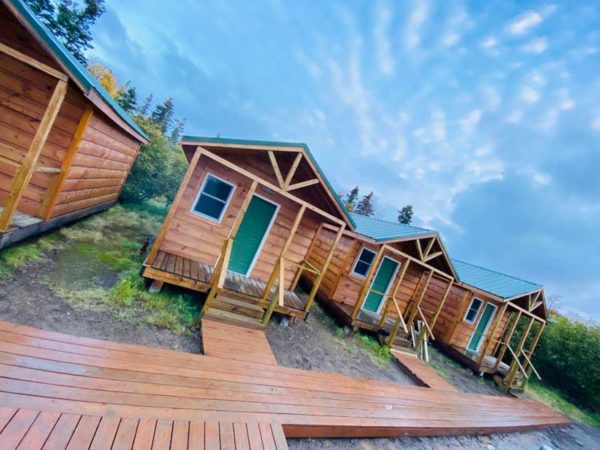
We’ve just departed camp. It’s finally all said and done. I am a bit awestruck that we are finished. The transformation to a top-shelf Bristol Bay lodge is truly astounding. The amount of planning, thinking, money and man power that went into this metamorphosis from a dilapidated fish camp to a world-class Alaska fishing lodge is near incomprehensible. I must admit I am a little emotional. When I look around at what my family, friends, team, and I have created, I get a little choked up. Maybe I am a little more sentimental in my 60th year, but I am enormously proud of this slice of heaven on the Nushagak River in Alaska that we call home each summer. I am deeply grateful to my team and camp staff as much as my loved ones for supporting me throughout this whole endeavor, enduring my absence and contributing their own talents.
The work will never really be done, but the bulk of it is over. There’s always annual maintenance, staining the lodge, repairing anything necessary, keeping it all in tip-top shape. We’ve upgraded everything else too, from the business practices and brand identity to client communication, social media and website. At last there will be a lot more time for fishing and relaxing with our treasured guests! It’s incredible during this time we went from 72 guests the year prior to buying it, then to 92 in 2017. We hosted 146 anglers in 2018 then a whopping 210 visitors in 2019. In 2020 we were shut down, but next year is going to be our best year yet with over 260 guests and we are already booked full!
I had no idea at the beginning of all this the magnitude of what I was getting into when I stepped into this role as a Bristol Bay lodge owner. I’m neck deep now and it’s been an enormous growth experience both personally and professionally. Not without trials, my team is stronger and wiser for the wear. And the outcome is we’ve got one incredible lodge on the best salmon river in Alaska where we can relax and enjoy.
